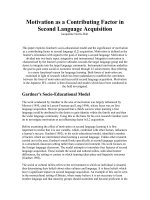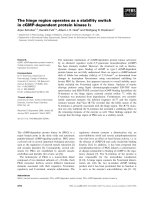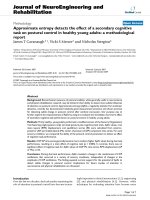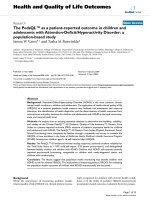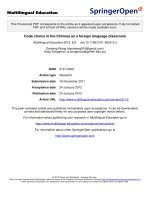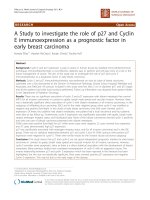The dictionary as a secondary source in language learning
Bạn đang xem bản rút gọn của tài liệu. Xem và tải ngay bản đầy đủ của tài liệu tại đây (1.88 MB, 17 trang )
The Dictionary as a Secondary Source in Language Learning
Author(s): Joel Walz
Source: The French Review, Vol. 64, No. 1 (Oct., 1990), pp. 79-94
Published by: American Association of Teachers of French
Stable URL: />Accessed: 17-02-2017 09:31 UTC
JSTOR is a not-for-profit service that helps scholars, researchers, and students discover, use, and build upon a wide range of content in a trusted
digital archive. We use information technology and tools to increase productivity and facilitate new forms of scholarship. For more information about
JSTOR, please contact
Your use of the JSTOR archive indicates your acceptance of the Terms & Conditions of Use, available at
/>
American Association of Teachers of French is collaborating with JSTOR to digitize, preserve and
extend access to The French Review
This content downloaded from 42.118.117.253 on Fri, 17 Feb 2017 09:31:25 UTC
All use subject to />
THE FRENCH REVIEW, Vol. 64, No. 1, October 1990 Printed in U.S.A.
The Dictionary as a Secondary Source
in Language Learning
by Joel Walz
II y avait des canards sur le'ang qui criaient
<Charlatan! Charlatan!>
VERY FEW TEACHERS have never laughed or groaned at student compositions
that contain errors such as the one above. Even though we know exactly
what the source is-improper use of a dictionary-we nevertheless permit
such errors to recur year after year. The problems are polysemy, or a word
having more than one meaning, and homonyms, which are different words
that are pronounced or spelled alike. When students look up an English
word in a bilingual dictionary, they find most or all of its meanings repre-
sented by French equivalents. Since many dictionaries do not give the
semantic field of each translation (Al-Kasimi 67; Ianucci), the student decides to guess. Even when the dictionary does add fields, students do not
understand or do not pay attention and end up choosing the wrong word.
Thus, the student quoted above who looked up quack may have found
charlatan; coin-coin and not realized that the semi-colon separated the semantic fields of dubious professions and animal noises.
We must ask ourselves whether students have the right abilities to accomplish the tasks we demand of them. In the first few weeks of instruction, we sometimes ask for totally original compositions for which we
provide no structure. A survey of foreign language teaching literature of
the last twenty years shows relatively little information on dictionary use.1
One could therefore question whether foreign language teachers consider
dictionary use a skill worth teaching. The purpose of this article is to
examine this question and to determine what teachers can do to improve
the situation.
Students associate many negatives with the foreign-language dictionary.
The very word itself conjures up images of a yellowing, dog-eared paperback missing about half the words a student wants to know. As Heilenman
states, it is "a nice place to visit, but no one wants to live there" (43).
Dictionary use is synonymous with failure; students use it almost exclusively to look up words in a reading passage that they do not know (decoding) or to find a French equivalent of an English word that they want to use
79
This content downloaded from 42.118.117.253 on Fri, 17 Feb 2017 09:31:25 UTC
All use subject to />
80
in
FRENCH
a
REVIEW
composition
(en
tion
increases
(Hug
cause
students
to
l
fact
of
slowing
dow
mond).
Bensoussan
results
of
a
readin
In
writing,
student
inclined
to
pursue
Indeed,
many
exp
may
be
the
two
w
dictionary
use
sho
time
teaching
stud
(Hosenfeld
et
al.).
reading
and
writin
example,
in
a
revie
discursive
and
the
definitions
and
tha
of
vocabulary
that
individual
words
(13
processing
approac
thermore,
anyone
vocabulary
must
f
if
the
student
is
t
arranged
in
alphab
while
many
teache
up
a
word,
it
is
unl
On
the
other
han
importance
diction
reading
and
writin
the
scholars
publis
words
from
contex
that
guessing
depe
the
sentence
to
c
Strasheim
used
to
study,
thought
th
time
the
teacher
s
classes,
Groebel
fo
unknown
words
in
should.2
During
th
reading
passages
c
(Northeast
Conferen
that
have
not
been
textbooks,
includin
instead
encourage
guessing
(Schofer
This content downloaded from 42.118.117.253 on Fri, 17 Feb 2017 09:31:25 UTC
All use subject to />
DICTIONARY IN LANGUAGE LEARNING 81
less than half the time when confronted with
context. Allen et al. found that all students in
something from the authentic passages th
students "something" is not enough. They
to know how to use it.
Perhaps the best argument for dictionary use is that it is the essential
source for information about words in a language (Marckwardt). Peda-
gogues have long decried the lack of attention paid to vocabulary in
foreign-language teaching (e.g. Nemni, Carter). Proper vocabulary use is
an essential part of communicative interaction. While reading experts
stress guessing words from context, many place vocabulary as the most
important element in understanding (see Adams 155 and her references).
Many of the native-speaker reaction studies done several years ago found
that errors in vocabulary had a more profound effect on comprehensibility
and sensitivity than did errors of grammar or pronunciation (Ludwig 276).
Bonin tested advanced undergraduate French majors to see whether they
could understand spoken, colloquial French. She found that vocabulary
created more misunderstandings than any other aspect of oral language.
More recently, scholars interested in testing oral proficiency have developed a chart of the relative contribution of each aspect of language to total
production (Higgs and Clifford 711). At the novice level, vocabulary is far
ahead of the other components (grammar, pronunciation, etc.). Since the
vast majority of foreign language students in this country operate at the
novice level, we cannot overlook this aspect of language.
A second major reason for teaching dictionary use is that it can be a tool
for lifelong learning. Linguists have pointed out that native speakers learn
the syntax of a language in very few years, but they add to their vocabular-
ies throughout their entire lives (Richards 83). Currently, much of what is
recommended in foreign language pedagogy is based on the false assumption that we can predict what vocabulary our students will need in the
future (Twaddell). A good example of this tendency is the "proficiencyoriented teaching" that is currently in vogue. Proponents specify exactly
what semantic fields should be taught at the early levels (ETS, Omaggio).
Many states are following this advice and repeating the fields in state
curriculum guides. Teachers will not object because the topics are generally
those taught in first-year textbooks already (foods, clothing, colors, family
members). However, we should not classify this as responding to student
needs since students themselves may not know what their needs are. It is
important to teach the skills needed to continue expanding one's vocabulary (Rivers, Teaching Foreign 466; Twaddell).
If we are to develop a nation of bilinguals, we need to place more emphasis on language learning after traditional instruction has stopped. Studies of
loss and maintenance of language skills are in their early stages (Freed and
Lambert). Certainly dictionary use is an essential skill, perhaps the most
important one, for a person who needs to revive language skills, but who
This content downloaded from 42.118.117.253 on Fri, 17 Feb 2017 09:31:25 UTC
All use subject to />
82
FRENCH
REVIEW
has no human source of information. We also need to consider the non-
traditional student in our language classes (see Joiner). With older learners
and returning students we are even less likely to be able to predict their
needs. Thus, it seems essential to develop students' ability to continue
learning on their own or, at least, to branch out in the directions that their
specific interests take them. For example, students may need to know
about the availability of and how to use specialized dictionaries, such as
those for business, data processing, medecin, and economics (for a complete
listing, see section 03 0.3 Dictionnaires techniques of the subject volume of Les
Livres disponibles). The AATF Commission on Professional Standards states
that every teacher of French should have dictionary skills and should know
how to teach them (AATF 15).
A third reason for teaching the use of the dictionary is that it is not a dull,
dry reference book and that it can be used for more than just practicing safe
lex. (Those who think dictionaries are boring have never looked up mec or
nana in the Dictionnaire du franfais argotique et populaire!) Some of the new
dictionaries in particular are so fascinating that they can be considered as
documents authentiques in their own right and potentially as interesting as
many of the periodicals that teachers use in class. If presented in the proper
way, many dictionaries will entertain as well as instruct.
Dictionaires are useful in two distinct ways in language learning. As a
secondary source, they help bring about the understanding of a text, the
primary source as received or produced by students, provided that teachers
have developed in their students the skills necessary to use dictionaries
correctly. These skills will be the subject of the second part of this article.
Many scholars have called for the teaching of these skills (Al-Kasimi 108;
Herbst and Stein; Loew; Medley; Rivers, Teaching French 304-08.) I will
attempt to summarize and expand upon their ideas and provide a model for
implementation. Dictionaries also vary widely in form and content and can
provide learning opportunities in and of themselves. Such activities will be
presented in the December issue of The French Review in an article entitled
"The Dictionary as a Primary Source in Language Learning."
Two important questions to consider are how and when to teach dictionary skills in class. The first has several answers. In limited cases, teachers
can ask students to bring their dictionary with them to class. This is not
practical very often since there are many basic dictionaries from which
students can learn, and few students buy more than one. A more reasonable system would be to have a learning area in class (Hammerly 578) or in
the library where students have a variety of dictionaries available and
where they can work in small groups on the same book. At colleges and
universities this situation will be less of a problem since they have larger
budgets for reference works. Faculty will want to verify the possibilities
and expand on titles or acquire more recent editions as funding permits.
High school budgets are smaller, but, in dealing with authorities, teachers
This content downloaded from 42.118.117.253 on Fri, 17 Feb 2017 09:31:25 UTC
All use subject to />
DICTIONARY IN LANGUAGE LEARNING 83
may be able to use the call by the AA
Standards for library purchase of refere
The when of teaching dictionary use c
integral part of the language course and in
class as to what dictionary students shou
then continues throughout the course w
competitors' books and other types of d
assign one day a week or every two week
the day that compositions are due so tha
composition and prepare a normal textbo
concentrate on finishing the compositi
presentation of a dictionary and exerci
approach is to develop learning packets t
ized instruction of the 1970s (Logan). A p
explanations and specific directions for s
the packets in many situations: during a
illness, in classes of mixed levels that are
(Book), or for independent study or ad
students. Even at the graduate level, wo
useful, especially since so few undergrad
area. Many departments offer research m
courses where this type of work would
learning dictionary use is flexibility; it c
dent. It can be the focus of the lesson or a
elementary or advanced.
The most dramatic use of dictionaries
course in lexicography. Since Les Livres d
under its subject heading for dictionari
material for an entire course on diction
learning French through the use of thes
than teaching how to compile a dictionary,
raphy in the strictest sense. It would, h
experience.
Before planning lessons based on dictionaries, one should consider three
of the most frequently asked questions concerning their use: whether to
use a monolingual or bilingual dictionary; when to look up a word (and, by
extension, what words) while reading; and what is currently the "best"
dictionary of each type. The fact that teachers have debated these questions
for generations without coming to any universally-accepted conclusions
does not bode well for this discussion, but a review of the literature may
prove helpful.
Most teachers have probably decided what type of dictionary-monolin-
gual (MD) or bilingual (BD)-students should use; many either order or
recommend a specific title. Interestingly, two researchers who have surveyed published opinion concerning the merits of each type reached oppo-
This content downloaded from 42.118.117.253 on Fri, 17 Feb 2017 09:31:25 UTC
All use subject to />
84
FRENCH
site
REVIEW
conclusions.
A
distinctions
of
equ
tion
on
permissibl
and
opposing
choic
using
BDs
invariab
on
the
other
hand,
the
student
must
k
encoding.
He
also
b
they
must
also
loo
circular
definitions:
Richards
states
th
uses,
its
limitation
this
as
an
argumen
Baxter
also
prefers
lanucci
points
out
t
tioned
above.
Lind
they
give
the
imp
every
word
in
one
that
BDs
may
lead
language
is
tantam
BDs
also
have
more
Joseph)
or
translat
(Denoeu).
On the other hand, Nemni points out that the short, frequent words
used in early language instruction are often the hardest to explain (e.g. rire,
1030). She wonders how a student who looks up one unknown word will
understand all the words of the definition. Hammerly sees BDs as preferable, even necessary, at the elementary and intermediate levels. He cites
Dodson's "eureka experience" (572), where the student, upon understanding a definition, immediately converts it to a native-language equivalent.
Al-Kasimi presents the same arguments in favor of BD use at all levels of
instruction (103-04; see Ilson also for other arguments). One might conclude that the controversy is not an easy one to solve. While decoding
(reading and perhaps listening), students will probably save time by using
BDs to avoid converting the definition to a native equivalent. With encod-
ing (writing and perhaps speaking), students could use MDs to reduce
errors and BDs to increase the possibilities of communication. The activi-
ties below teach the use of both.
The second question concerning dictionaries that teachers often ask is
when a learner should consult a dictionary. Most researchers have commented only on reading in this respect, and the verdict has been nearly
unanimous for over thirty years: only as a last resort (Jones, 1957; Hosenfeld et al.; Medley; Rivers, Teaching Foreign 304). "Last resort" has been
variously defined as after reading the entire passage (Jones 128) or at least a
complete sentence (Twaddell 76). The problem reading experts have not
This content downloaded from 42.118.117.253 on Fri, 17 Feb 2017 09:31:25 UTC
All use subject to />
DICTIONARY IN LANGUAGE LEARNING 85
addressed is how students are to know
problem that occurs not infrequently
When the last resort is reached, studen
message properly.
The corollary to this question is what
facetious answer-words they do not k
appear obvious but are not. Research do
of speech will help more than others whi
guess nouns and verbs over all others,
an enormous amount of information a
stressing that the whole (meaning) is
(words), it is unlikely that such resear
tioned above, Bensoussan finds that di
improve reading comprehension. The p
Given the sentence The children are looki
French students might look up (or at leas
use no article with television. An exerc
divide sentences into units that they can
The third question (which dictionary is b
sible, to answer. It is important to com
classification system, such as that of G
that monolingual French dictionaries fa
public cultiv, . . . au grand public ... au
this does not include many specialized
Teachers would also do well to keep up
ies, which appear in the major profess
articles that compare them (Ibrahim). Y
ing dictionaries for ESL students that
rand's article comparing the Petit Robe
contemporain can serve as a model for com
ies, and it will be used in the sequel ar
language classes.
Teachers much choose relevant words
is possible with the specific dictionary
ing examples of learning activities may se
want to replace or supplement them w
their own situation. The class textbook
lary for any given assignment. Student
a good beginning for expanding vocabu
a role in determining the type of work
Teachers who prepare printed lessons f
update them regularly to ensure an in
Above all, the vocabulary and the cont
students' level.
This content downloaded from 42.118.117.253 on Fri, 17 Feb 2017 09:31:25 UTC
All use subject to />
86
FRENCH
Learning
REVIEW
Activities
For
suggestions
ab
tant
types
of
dict
produce
target
lan
ing
dictionaries
to
suggests
examinin
teaching
parts
of
s
order,
finding
der
bols,
checking
spel
Rivers
(Teaching
Fr
terest
in
the
dictio
She
recommends
s
Larousse,
with
its
m
students
become
ac
06).
Rossner's
sugg
a
certain
word
is
a
The
most
complet
(Whitcut)
and
Oxf
foreign
students.
F
ple
entry
and
disc
various
aries,
type
faces.
teachers
W
can
entry
to
a
transpare
Robert
BD
has
a
det
xxiv)
and
the
Petit
Decoding
A
decodes
detailed
criticizes
without
involves
our
analys
the
teaching
can
words
mark
out
smaller
becomes."
U
st
understan
students.
teachers
of
Monoling
student
most
He
I
(even
any
the
His
have
st
if
t
inflec
diction
A. Rayez les prffixes et les suffixes des mots suivants, s'il y a lieu.
inaccessible preconsonantique
pitoyablement incrtdulith
enrichissons anticonstitutionnel
parlement rtduisant
archifaux anhimoine
This content downloaded from 42.118.117.253 on Fri, 17 Feb 2017 09:31:25 UTC
All use subject to />
DICTIONARY IN LANGUAGE LEARNING 87
(Parlement and antimoine are traps, wo
entirety.)
Another step in Scholfield's system is to reduce multiple entries by elimi-
nation. Students must recognize parts of speech, grammatical information
(e.g. transitive or intransitive), level of style, word combinations, and infer-
ences. The person who composes the exercise should look for words that
students do not know in a context that they will understand.
B. Cherchez les mots soulignes dans votre dictionnaire et ecrivez la definition qui y
correspond au-dessous de la phrase.
1. I1 faut que j'aille chercher des timbres au bureau de poste.
2. Vous n'avez pas le droit de me dire cela.
3. Son fiance lui a offert un bracelet en argent.
4. Un tel investissement ne vous rapportera rien.
5. Elle est partie acheter des piles pour son walkman.
6. Aprs l'inondation, son champ 6tait couvert de vase.
7. Il est revenu du vin d'honneur compkltement noir.
8. Puisque l'eau avait un goat infect, je I'ai balancie.
Underhill and Whitcut recommend similar exercises based on polysemy,
but since students are all consulting the same dictionary, they can use the
number of the correct definition instead of writing it out. Scholfield emphasizes fitting the right definition into the context of the sentence (his
sixth step). Exercise B above can be done with an entire class in order to
find out which word(s) give the key to the correct meaning, or the teacher
can ask students to circle them. For example, in sentence eight, the word
infect suggests that the underlined word means to throw out. Using words
students know, but in a different sense (argent, noir), or false cognates
(vase, balanc&e), will encourage them to read the complete entry. A variation of exercise B is also possible; Underhill takes one word with several
meanings, gives a sample sentence for each, then asks students to pair
usage and definitions (32-33).
Decoding / Bilingual Dictionaries (examples from Collins-Robert)
The first characteristic of bilingual dictionaries to examine is whether or
not they separate the English equivalents of French entries into semantic
fields. BDs will always have many more equivalents than BDs have definitions because the former list synonyms. An older dictionary may separate
semantic groups by semi-colons and synonyms within a group by commas.
For example, the 1962 edition of Cassell's gives nineteen English verbs for
gener separated by five semi-colons (i.e. six semantic groups), before giving
five examples. The Collins-Robert (1987) separates four fields (physiquement, deranger, financierement, and mettre a l'aise). It subdivides the first
two and gives nineteen examples in all.
An exercise to practice finding the right native language equivalent
This content downloaded from 42.118.117.253 on Fri, 17 Feb 2017 09:31:25 UTC
All use subject to />
88
FRENCH
would
REVIEW
resemble
semantic
fields.
correct
meaning
teacher
can
help
an
easily
understan
underlined
from
field.
C.
Cherchez
6.
7.
8.
word,
not
using
Exercise
C
semantique
1.
2.
3.
4.
5.
B
B
of
d
les
et
the
ask
mots
une
s
trad
Ils
ont
refus4
de
pay
Nos
voisins
pratiqu
Le
bibi
veut
qu'on
Quand
vous
serez
&
I
y
a
une
petite
bat
Cette
11I
11
a
a
route
echout
Translating
dents
vous
prisenth
des
parce
m
id
q
only
concentrate
o
ponds
more
closely
unknown,
while
c
tion exercise.
Encoding / Monolingual dictionaries
The great advantage for using MDs for encoding is that it limits students
to using words they already know. They can verify the correct spelling
look for a verb conjugation, recheck meanings (to avoid faux amix, for
example), or see what words go together, that is, collocations. We try to
avoid clich6s in our native speech but seek them out in a foreign languag
The only collocation dictionary for French (Lacroix) is out of print; Hau
mann feels that no good dictionary of this type is feasible because word
combinations are too unpredictable. On the other hand, he describes learn
ing a language as learning its collocations (195).
Teachers spend a considerable amount of time teaching fixed combinations of words. Even elementary texts have lessons on which preposition
follow verbs and idiomatic expressions with avoir and faire. Exercise D i
based on the Petit Robert since the Petit Larousse is less suited for findin
word combinations.
D. Complrtez les phrases suivantes avec les mots qui conviennent.
1. Vous voulez le petit dbjeuner maintenant?
2. Vous jouez au tennis? Quels autres sports -vous?
3. N'entrez pas dans leur jardin! Ils ont un chien
This content downloaded from 42.118.117.253 on Fri, 17 Feb 2017 09:31:25 UTC
All use subject to />
DICTIONARY IN LANGUAGE LEARNING 89
4. J'hesite vous reprocher cela pa
erreur.
5. Elles se ressemblent beaucoup; elles sont comme gout
d'eau.
6. Quand il a annoncd la nouvelle, il a la panique.
7. On le reconnatt facilement sa barbiche.
8. Je ne sais pas ce que j'ai, mais je ne suis pas mon assiette.
Some sentences may allow more than one answer (#1, 3) but students will
be able to reach a consensus if the context is clear.
Underhill gives exercises that let students learn to use the dictionary to
find synonyms, to distinguish words that are often confused (loose, lose), and
to use prefixes and suffixes to form new words (employ -> unemployable)
(Chapter 5). Whitcut emphasizes word use and collocations. All of these are
adapatable to French.
Encoding / Bilingual dictionary
Most trouble that students encounter using a dictionary probably concerns encoding with a BD; the inscription at the beginning of this article is
an authentic example. A first step to proper BD use is to show students the
necessity of looking up a word in both sections of the dictionary (Heilenman; Rivers, Teaching French 307). They look up the English word and find
possible French equivalents. They then look up each equivalent in the
French section (especially if their BD does not give semantic fields) to see
what each means in English. A good example to start with is the word
poisonous. The dictionary entry in Collins-Robert includes:
snake venimeux; plant veneneux; gas fumes toxique
The concept is simple: English has one word, but French distinguishes
among the carriers of the poison. Darbelnet calls this phenomenon a bifurcation (240). Students learn some frequent ones in elementary classes: to
know-savoir or connaitre and can-pouvoir or savoir. The reverse also
exists: faire-to make or to do and dire-to say or to tell. Words to look up
might include: to run (a store), to work (i.e. machine), to drive (someone
crazy), size (of a coat), and drinkable.
Not only do individual words have several meanings, and therefore
many equivalents in the other language, but homonyms also add to the
problem of finding an appropriate equivalent. Students must again use
semantic fields and both halves of the BD to find the right word, just as
they would search for the right meaning with MDs. Rivers presents an
exercise to practice looking for multiple meanings; she lists eight sentences
with the word picture used in different ways that students are to translate.
The advantage of the exercise is that it forces students to confront multiple
entries that exhaust almost all possibilities and that it integrates semantic
This content downloaded from 42.118.117.253 on Fri, 17 Feb 2017 09:31:25 UTC
All use subject to />
90
FRENCH
fields
REVIEW
and
simplifies
parts
the
of
task
b
meanings
and
askin
(47).
French
studen
E.
Traduisez
1.
Let's
2.
It's
3.
4.
It's
meet
nice
a
He's
at
to
bad
mots
the
meet
res
you
movie.
aTad
(Polyshmie)
5.
6.
7.
8.
les
child.
Do
you
know
how
t
What
program
are
Do
I
have
to
wear
a
We'll
have
to
tie
it.
If
the
encoding
is
recognize
lexical
un
exercise
would
hav
indicate
the
units.
when
you
dropped
are
each
one
unit,
Another
select
an
way
to
obvious
b
an
de
dic
special
way
(e.g.
a
g
the
proper
word.
originally
and
all
i
chosen
right
incorrectly
a
word
and
exp
copying
pages
and
quickly.
Certainly, students cannot develop these skills to their maximum potential if they do only five exercises. However, teachers can direct the use of
monolingual and bilingual dictionaries so that students learn how to use
them in a judicious manner and that they find correct meanings and equivalents. In this way the dictionaries serve as a secondary source to help in
the comprehension of the written and oral texts that are the primary
source of learning. These texts are thus more enjoyable, and learning is
enhanced.
UNIVERSITY OF GEORGIA
Notes
1Most of the work I found comes from ESL publications (see references). Since ESL
teachers often have students of widely varying native languages in these classes, they are
This content downloaded from 42.118.117.253 on Fri, 17 Feb 2017 09:31:25 UTC
All use subject to />
DICTIONARY IN LANGUAGE LEARNING 91
unlikely to be able to provide target language equiv
even more important in ESL classes. A second impor
have very specific and highly technical needs rela
group French-as-a-foreign-language students toge
issues to dictionaries, however: Applied Linguistics 2
(1983); International Journal of American Linguistics
and Lexique, vol. 2 (n.d.). Cowie has an extensive b
2There is quite a bit of information on how people
the survey by Quirk. In second/foreign language
Groebel, and Tomaszczyk. Hartmann presents an o
3Lagane edited a supplementary booklet to train use
porain. It is for native speakers, but can be adapted
les dictionnaires et les encyclopidies presents exerci
works. Many of them are also adaptable to Americ
dictionaries.
41 chose the Petit Larousse because students enjoy
dictionary to list new words in the French languag
probably want to use the Petit Robert (Rivers, Teach
5This exercise is simple to create. Look through th
larger than the one students use and pick words th
archifaux and pr&consonantique, as well as verb for
Works Cited
Adams, Shirley J. "Scripts and the Recognition of
Language Reading Skills." ML] 66 (1982): 155-5
Al-Kasimi, Ali. Linguistics and Bilingual Dictionarie
Allen, Edward D., Elizabeth B. Bernhardt, Mar
"Comprehension and Text Genre: An Analysis
Readers." ML] 72 (1988): 163-72.
American Association of Teachers of French. The
tence. The Preliminary Report of the Commission
Bulletin 13, Spec. issue (1987).
Ard, Josh. "The Use of Bilingual Dictionaries by ESL
Applied Linguistics 58 (1982): 1-27.
Baxter, James. "The Dictionary and Vocabulary B
TESOL Quarterly 14 (1980): 325-36.
Bejoint, Henri. "The Foreign Student's Use of Mon
Language Needs and Reference Skills." Applied L
Bensoussan, Marsha. "Dictionaries and Tests of EF
37 (1983): 341-45.
Bonin, Th&rese M. "The Role of Colloquial French
Language Instruction." ML] 62 (1978): 90-102.
Book, Leon C. "Teaching Multi-Level Classes: A
Acquisition: Preparing for Tomorrow. Ed. Barba
Conference on the Teaching of Foreign Lang
book, 1986: 109-14.
Caradec, Frangois. Dictionnaire du francais argotiq
Carter, Ronald. "Vocabulary and Second/Foreign
20 (1987): 3-16.
Collins-Robert French-English English-French Dicti
Cowie, Anthony, ed. The Dictionary and the Lang
This content downloaded from 42.118.117.253 on Fri, 17 Feb 2017 09:31:25 UTC
All use subject to />
92
FRENCH
Seminar
at
Tiibingen:
Darbelnet,
Denoeu,
REVIEW
the
Unive
Niemeyer,
Jean.
Pensee
Francois.
"Am
"Dictionnaires
et
encyc
Educational
Testing
Ser
Freed,
Barbara
F.
and
Newbury
House,
1982
Galisson,
avance."
Robert.
Etudes
"Ima
de
Ling
Geeraerts,
D.
"Dictiona
Applied
Linguistics
63
Girardin,
Chantal.
(1979):
84-99.
"Con
Groebel,
Lillian.
"Read
ommended
Method."
Hammerly,
Hector.
"C
Modern
Language
Rev
Hartmann,
R.R.K.
"Fo
Methods." Cowie 11-28.
Hausman, F. "Un dictionnaire de collocations est-il possible?" Travaux de Linguistique et de
Litt&rature 17, i (1979): 187-95.
Haynes, Margot. "Patterns and Perils of Guessing in Second Language Reading." On TESOL
'83: The Question of Control. Ed. Jean Handscombe, Richard A. Orem, and Barry P. Taylor.
Washington, DC: TESOL, 1984, 163-76.
Heilenman, Laura K. "Foreign Language Vocabulary Learning and Native Language Processes." Personalizing Foreign Language Instruction: Learning Styles and Teaching Options. Ed.
Renate A. Schultz. Skokie, IL: National Textbook Co., 1977, 43-52.
Herbst, Thomas and Gabriele Stein. "Dictionary-Using Skills: A Plea for a New Orientation in
Language Teaching." Cowie 115-27.
Higgs, Theodore V. and Ray Clifford. "The Push Toward Communication." Curriculum Competence and the Foreign Language Teacher. ACTFL Foreign Language Education Series. Ed.
Theodore V. Higgs. Lincolnwood, IL: National Textbook, 1982, 57-79.
Hosenfeld, Carol, Vicki Arnold, Jeanne Kirchofer, Judith Laciura and Lucia Wilson. "Second
Language Reading: A Curriculum Sequence for Teaching Reading Strategies." Foreign
Language Annals 14 (1981): 415-22.
Hughes, George and Clark Chinn. "Building Reading Vocabulary through Inference: A Better
Classification of Context Clues." Second-Language Acquisition: Preparing for Tomorrow. Ed.
Barbara Snyder. Report of the Central States Conference on the Teaching of Foreign
Languages. Lincolnwood, IL: National Textbook, 1986, 93-108.
Iannucci, James E. "Meaning Discrimination in Bilingual Dictionaries." Problems in Lexicography. Ed. Fred W. Householder and Sol Saporta. International Journal of American Linguis-
tics 28.2, Part IV (1962): 201-16.
Ibrahim, Amr Helmy. "Choisir un dictionnaire." Le Francais dans le Monde 218 (1988): 48-53.
Ilson, Robert, ed. Dictionaries, Lexicography and Language Learning. Oxford: Pergamon, 1985.
Joiner, Elizabeth G. The Older Foreign Language Learner: A Challenge for Colleges and Universi-
ties. Language in Education: Theory and Practice 34. Washington, DC: Center for Applied
Linguistics, 1981.
Jones, Willis Knapp. "Cultivating Reading Speed in Spanish." ML] 41 (1957): 126-30.
Joseph, John Earl. Review of Cassell's French and English Dictionary. ML] 71 (1987): 94.
Judd, Elliott L. "Vocabulary Teaching and TESOL: A Need for Reevaluation of Existing Assumptions." TESOL Quarterly 12 (1978): 71-76.
This content downloaded from 42.118.117.253 on Fri, 17 Feb 2017 09:31:25 UTC
All use subject to />
DICTIONARY IN LANGUAGE LEARNING 93
Lacroix, U. Les Mots et les idies: dictionnaire des ter
Paris: Fernand Nathan, 1967.
Lagane, Rend, ed. Dictionnaire du francais contempo
1971.
Lindstrom, Naomi. "Making the Bilingual Dictionary Safer for Students." Hispania 63 (
718-23.
Les Livres disponibles 1989. Paris: Editions du Cercle de la Librairie, 1988.
Loew, Helen Z. "Developing Strategic Reading Skills." Foreign Language Annals 17 (1
03.
Logan, Gerald E. "Curricula for Individualized Instruction." Individualization of Instruction.
ACTFL Review of Foreign Language Education. Vol. 2. Ed. Dale Lange. Skokie, IL: National Textbook, 1972, 133-55.
Ludwig, Jeannette. "Native-Speaker Judgments of Second-Language Learners' Efforts at
Communication: A Review." MLJ 66 (1982): 274-83.
Magnan, Sally Sieloff. "Teaching and Testing Proficiency in Writing: Skills to Transcend the
Second-Language Classroom." Proficiency, Curriculum, Articulation: The Ties That Bind. Ed.
Alice C. Omaggio. Middlebury, VT: Northeast Conference on the Teaching of Foreign
Languages, 1985. 109-36.
Marckwardt, Albert H. "The Dictionary as an English Teaching Resource." TESOL Quarterly
7 (1973): 369-79.
Medley, Jr., Frank W. "Reading Assignments versus Reading Instruction: Native Language
Strategies and Techniques for Use in the Foreign Language Classroom." Personalizing
Foreign Language Instruction: Learning Styles and Options. Ed. Renate A. Schulz. Skokie, IL:
National Textbook, 1977, 29-42.
Mitterand, Henri. "Deux dictionnaires franqais: le Petit Robert et le Dictionnaire du Francais
Contemporain." Le Franfais dans le Monde 59 (1968): 24-29.
Miiller, Bodo. Le Francais d'aujourd'hui. Trans. Annie Elsass. Paris: Klincksieck, 1985.
Nemni, Monique. "Les Maux des mots." Canadian Modern Language Review 41 (1985): 102040.
The New Cassell's French Dictionary. French-English English French. New York: Funk and Wag-
nalls, 1962.
Northeast Conference on the Teaching of Foreign Languages. "Language Learning: The
Intermediate Phase." Reports of the Working Committees. Ed. William F. Bottiglia. Middlebury, VT: Northeast Conference, 1963.
Omaggio, Alice C. Teaching Language in Context: A Proficiency-Oriented Approach. Boston:
Heinle and Heinle, 1986.
Petit Larousse illustre 1989. Paris: Larousse, 1988.
Porte ouverte sur. . . les dictionnaires et les encyclopidies. Paris: Hachette, 1984.
Quirk, Randolph. "The Image of the Dictionary." The Linguist and the English Language.
London: Edward Arnold, 1974, 148-63.
Raymond, Patricia. "Interference in Second Language Reading." Canadian Modern Language
Review 44 (1988): 343-49.
Richards, Jack C. "The Role of Vocabulary Teaching." TESOL Quarterly 10 (1976): 77-89.
Rivers, Wilga M. Teaching Foreign-Language Skills. 2nd ed. Chicago: U of Chicago P, 1981.
Teaching French: A Practical Guide. 2nd ed. Lincolnwood, IL: National Textbook, 1988.
Robert, Paul. Le Petit Robert 1. Dictionnaire alphabitique et analogique de la langue franfaise.
Nouvelle 6dition. Paris: Le Robert, 1985.
Rossner, Richard. "The Learner as Lexicographer: Using Dictionaries in Second Language
Learning." Ilson 95-102.
Schofer, Peter and Donald Rice. Autour de la litt&rature: kcriture et lecture aux cours moyens de
francais. Boston: Heinle & Heinle, 1987.
Scholfield, Phil. "Using the English Dictionary for Comprehension." TESOL Quarterly 16
(1982): 185-94.
This content downloaded from 42.118.117.253 on Fri, 17 Feb 2017 09:31:25 UTC
All use subject to />
94
FRENCH
REVIEW
Swaffar,
Janet
(1988):
123-49.
K.
"Rea
Thompson,
Geoff.
"Usi
Tomaszczyk,
Jerzy.
"D
Twaddell,
Freeman.
(1973):
61-78.
"V
Underhill,
Adrian.
Use
Wallace,
Michael
J.
Tea
Whitcut,
Janet.
Learni
Yorkey,
Richard.
"Wh
Quarterly
3
(1969):
25
This content downloaded from 42.118.117.253 on Fri, 17 Feb 2017 09:31:25 UTC
All use subject to />
